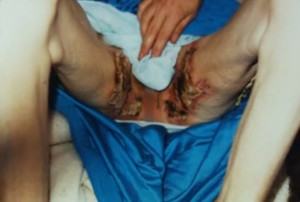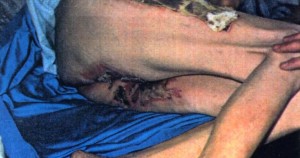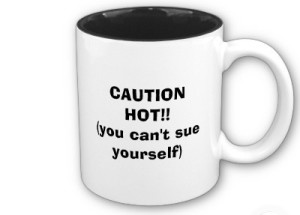
Want to be a millionaire? Step 1: Order hot coffee from McDonald’s Drive-Thru. Step 2: Careen down highway with careless abandon. Step 3: Dump hot coffee on self. Step 4: File lawsuit. Step 5: Pass “Go” collect $2.9 million. Sounds simple. Sounds like litigation is out of control. Sounds like something you would never do. Or is it?
These are the “facts” of the infamous case of Liebeck v. McDonald’s. Stella Liebeck is to tort reform, what Michael Jordan is to basketball. She embodies and symbolizes the Frivolous Lawsuit, The Runaway Jury, The Over-Litigiousness of America, Jackpot Justice, and everything that is wrong with the civil justice system. Or does she?
We know her case, or at least we think we do. What most Americans know about her is a distortion of the facts fed to them by tort deform astroturfers and insurance industry front groups like the American Tort Reform Association, Citizens Against Lawsuit Abuse, and the United States Chamber of Commerce.
Here’s the anatomy, fully dissected, of what insurance companies, large corporations, and other tort deformers, consider to be the epitome of a “Frivolous Lawsuit.”
FRIVOLOUS INJURY
Really? You are going to sue someone because your coffee was hot? What’s next? Sue the public works department because your water was too wet? Coffee is supposed to be hot. We’ve all turned the shower up too high or stuck our hands in dishwater that was an unpleasant temperature. Coffee is hot, but its not THAT hot. Cripes, big deal.

Well, it is a big deal if you are 79 years old, were hospitalized for 8 days with 3rd degree full thickness burns (down to the muscle and fat), underwent skin grafts and other surgeries, nearly died, and made your crotch look like Andrew Carnegie built an iron foundry on it. If you can handle it, this is what tort deformers, corporate america, and the insurance industry think a frivolous injury looks like:
WARNING! These photos are graphic, so skip it if you’re squeamish:
“Hello? Yeah, hey, McDonald’s-drive-thru-order-taker guy? I’d like to
order one coffee with cream and sugar. . . . Oh, could you also please
sear my genitals? Thanks a 2.9 million.”
Barely a flesh wound, really.
Gross. It’s Freddy Krueger, Nightmare On Elm Street all over the place.

Frivolous injury? Not a chance. But when you distort it enough into a simple digestible concept and have a theme that resonates with common misperceptions it’s an easy “common sense” argument to sell.
FRIVOLOUS USE OF THE COURTS
People are too quick to turn to the courts and make ridiculous demands for money way out of proportion to their injuries. She shouldn’t have to sue and use the courts to resolve her dispute. McDonald’s would have settled if she had just been reasonable. Its obvious what we have here; a Jackpot Justice, Money-Grubbing, evil, greedy plaintiff.
Can you believe this low-life devil-spawn asked McDonald’s to pay her for her medical bills ($12,500), along with $7,500 for her lost wages, pain and suffering. The nerve!
Seriously, she offered $20,000 to settle. No joke. McDonald’s response? $800. Take it or leave it. That’s corporate speak for, “Go fuck yourself.”
FRIVOLOUS LEGAL GROUNDS
Despite claims from tort deformers that judges should have “thrown out” Stella’s lawsuit and should “throw out” similar lawsuits, there simply wasn’t any legal or factual basis for the judge in this case to do so. A judge can’t throw out a case simply because it sounds kind of stupid. That would be the job of a dictator, not a judge. This case was on solid legal and factual footing and on all theories was fit to go before a jury.
FRIVOLOUS LIABILITY
Granted the injury is bad, but she spilled the coffee on herself doing donuts in her off-road truck in the middle of the New Mexico desert. Or was she drag-racing on Main Street? I forget, but either way, to hell with her, no rewards for stupidity.
In reality, she was a passenger in her grandson’s car. After they got their order from a McDonald’s drivethru in New Mexico, they pulled over in the parking lot to get situated and organized before they hit the road. The car didn’t have cup holders, so Stella had the coffee between her legs. As she tried to take the lid off to add cream and sugar, she spilled it. Not smart. It was an accident. But yes, she was certainly responsible for spilling it.
But that’s only half the story. Pursuant to corporate mandate, McDonald’s sold their coffee at surface-of-the-sun temperatures, 180-190 degrees. At that super-heated temperature, a spilled liquid is capable of causing full thickness burns in 2-7 seconds. Other similar establishments served coffee at significantly lower temperatures and coffee brewed at home is typically served at 135 to 140 degrees.
This creates a problem because a) most people have no way to know the temperature at which McDonlad’s serves their coffee and b) most people don’t realize the severity of the burns it can cause. It’s beyond common experience to think coffee could be so dangerous.
But it wasn’t beyond the experience of the largest, most sophisticated, coffee seller in the United States. McDonald’s knew about the risks posed by its coffee for more than a decade before Stella’s injury. It was brought to the company’s attention by other lawsuits and more than 700 reported claims, many of which involved 3rd degree burns similar to Stella’s. McDonald’s had notice that their coffee was dangerous, but they didn’t care.
The company’s witnesses testified that they held the coffee at scalding temperatures to maintain optimum taste, that they had no intentions of reducing the temperature, and that they never evaluated the safety ramifications of serving coffee at 180-190 degrees. They also admitted that the temperature at which McDonald’s poured their coffee was not fit for consumption because it would burn the mouth and throat. They knew their coffee was dangerous, did nothing about it, and didn’t intend to.
SHARED LIABILITY
Clearly McDonald’s and Stella both share responsibility for this injury. Now what? This type of situation is extremely common and not new to the law. In the United States there are two doctrines regarding shared liability between the plaintiff and the defendant. There are 5 jurisdictions, known as contributory fault jurisdictions, where a plaintiff is barred from recovering any money if they are even 1% at fault (Alabama, Washington D.C., Maryland, North Carolina, and Virginia.)
The remaining U.S. states have adopted a more just and sane approach known as comparative fault. These jurisdictions assign a percentage of fault to the tortfeasor and to the plaintiff and reduce the plaintiff’s final award in proportion to the plaintiff’s own fault.
Stella Liebeck’s case was venued in the comparative fault state of New Mexico. The jury found that she was 20% to blame for causing her own injury, which resulted in a 20% reduction in the amount of damages she was awarded.
FRIVOLOUS DAMAGES FROM A RUNAWAY JURY
Fine. Maybe McDonald’s shouldn’t have super-sized the temperature on their coffee, and they should be on the hook for something, but $2.9 million? Really? Come on. That’s too much bun for one burger. The amount awarded for damages in this country is RIDICULOUS.
Think about it this way. This was the decision of 12 thoughtful people on a jury. Ordinary people drawn from the community, not 12 people drawn from some kumbaya, Robin Hood, rob-from-the-rich-give-to-the-poor, commune. It was a decision based on clear instruction and understanding of the law and thoughtful deliberation on ALL the facts of the case. It was not a decision based upon some vague (mis)perception of the law and summarily arrived at by contemplating a few facts gleaned from soundbites and newspaper headlines.
Before people can say whether an award is “excessive” or not, it helps to have an actual understanding of what types of damages are recoverable in a personal injury case and why. Here’s the breakdown:
Economic Damages: Medical bills, lost wages, and those incidental expenses that would not have been incurred if not for the injury. They are designed to “make the plaintiff whole.” It’s obvious why we have these types of damages. If someone harms you, and it wasn’t your fault, then why should you have to pay the bills for it? You break it, you bought. Every 4-year-old knows that.
Non-Economic Damages: Pain, suffering, and inconvenience. These damages are also designed to “make the plaintiff whole.” The rationale behind non-economic damages aren’t as obvious as that of economic damages since there is nothing we can do to actually undo past pain and suffering. There is nothing we can do to actually prevent future pain and suffering. There is nothing we can do to actually bring back lost physical or mental abilities. But does it follow from this premise that we should then do nothing at all? I don’t think so, and the thousands of judges, lawyers, and litigants who, over hundreds (if not thousands) of years, have created the common law on which our tort system is based, don’t think so either.
The best we can do is offer monetary compensation. Justice is about fairness, and what is more fair? Nothing? Or money?
Punitive Damages: These damages are assessed solely to punish the defendant. Sort of like a newspaper swat to your dog after he pukes, but refuses to eat it. Many people think punitive damages are damages for “pain and suffering,” but that is incorrect. “Punitive” is an adjective that literally means “intended to punish.”
These awards are extremely rare and are awarded in only 2% of cases nationwide. To justify granting punitive damages in California, it must be shown by “clear and convincing evidence” that the defendant acted with “fraud, malice, or oppression.” In a nutshell, punitives are justified in two situations. The first situation is where the defendant purposely caused the harm, that is to say, the injury was intentional. If it was not intentional, the jury must conclude that the defendant engaged in conduct that was so vile, base, or contemptible that it would be looked down on and despised by reasonable people, AND that the defendant was aware of the probable dangerous consequences of his or her conduct AND deliberately failed to avoid those consequences. This is a very high standard and punitive damages are rarely justified.
Punitive damages developed as a matter of social policy. They are assessed to deter the defendant in the case at hand from repeating or continuing the offensive and despicable behavior and, by making an example of the defendant, to deter others from committing similar misconduct. Deterrence is achieved not only by the monetary award itself, but also from the resultant generation of negative publicity.
Acknowledging that the criminal justice system does not catch and punish all entities who wantonly violate the rights of others, punitive damages are designed to be quasi-criminal in nature. They are especially relevant in those cases where criminal prosecution is highly unlikely and where standard compensatory damages are relatively small. In these cases, punitive damages are the only means by which to deter and disincentivize socially harmful and despicable behavior.
The Jury Award
The jury awarded Stella $200,000 for her lost wages, medical bills and pain and suffering. This was slightly above what she asked for in her complaint. She had requested payment for medical bills in the amount of $12,500, lost wages in the amount of $5,000, and $125,000 for pain, suffering and permanent disfigurement. Honestly, that’s a pretty fair award. Could have been more, could have been less, as burns are notoriously painful.
The jury also awarded $2.7 million in punitive damages. In her complaint, Stella asked for a measure of punitive damages equal to 3 times the amount of her total economic and non-economic damages, which translated into roughly $600,000 based on the jury’s verdict. Obviously, the jury awarded more.
Why So Much For Punitive Damages?
The punitive damages in this case were meant to punish McDonald’s for its egregiously despicable behavior. Although the amount seems astronomical when looked at through the prism of injury compensation, it doesn’t seem so astronomical when looked at through the prism of McDonald’s punishment. Grimace and the Hamburgler got put in time-out, but thats about it.
It was this amount that the jury determined would appropriately punish McDonald’s and be an amount that would deter them and other’s from future similar conduct. The jury arrived at that number because it was roughly the equivalent of two days worth of McDonald’s coffee profits.
A jury has to take into consideration the ability of the defendant to pay so as to not unfairly burden or bankrupt the defendant, but also so that a large enough penalty is levied to change the defendant’s behavior and to act as a deterrent to other potential bad actors. All in all, the amount of punitive damages, although large, seems well reasoned.
Too High? Too Low? Too Hot? Then What?
At the end of the day, the jury awarded Liebeck $200,000 in compensatory damages, which the judge reduced to $160,000 in accordance with the jury’s finding that she was 20% at fault.
McDonald’s demanded a retrial, claiming that the verdict was improper. The judge refused, but did grant McDonald’s request for remittitur and reduced the punitive damages from $2.7 million to $480,000, even though he decried McDonald’s conduct at reckless, callous and willful. The final result: $640,000. Hardly a sum that supports the conclusion that verdicts are out of control. Rather, it does just the opposite. It exemplifies the checks and balances already implemented in the judicial process against “excessive” verdicts.
Both Stella and McDonald’s filed appeals. Before the appeals were heard, the parties reached an out-of-court settlement, reportedly for about $600,000. As a condition of the settlement, McDonald’s demanded that the exact amount of its payment to Stella be kept confidential.
McDonalds dropped the holding temperature of its coffee to 158 degrees Fahrenheit, started using sturdier cups and lids that are easier to remove and less prone to spill, and began adding cream and sugar before serving coffee at the drive-thru.
THE MORAL OF THE STORY?
 The fact that the tort reform lobby has relied on this case to convince the public that litigation is out of control and that the civil justice system is broken should make you skeptical of their motives, to say the least. Is the system perfect? No. Could certain aspects of it be better? Of course. Would modest reforms in certain problematic areas be beneficial? No doubt.
The fact that the tort reform lobby has relied on this case to convince the public that litigation is out of control and that the civil justice system is broken should make you skeptical of their motives, to say the least. Is the system perfect? No. Could certain aspects of it be better? Of course. Would modest reforms in certain problematic areas be beneficial? No doubt.
However, the tort deform lobby claims there is an epidemic stemming from a supposed glut of frivolous lawsuits, just like Stella’s case, clogging the civil justice system, resulting in outrageous awards. Their solution? Put caps on damages and limit access to the courts by expanding mandatory arbitration. Basically, gut the 7th Amendment. Got a headache? Cut your head off. These are seriously radical measures.
Think about this: If you are hurt, do you want to have a pre-set limit on the amount of money you can recover regardless of how bad your injuries are? If you are wronged, do you feel like giving up your ability to file a lawsuit and instead be forced to have your dispute resolved by a “neutral” party that sides with the party that wronged you 99% of the time? Is that justice? If your answer is no, then the “tort reform” movement is not your movement.
Who’s movement is it then? Who benefits? For an injured party, tort deform results in gross injustice. For the rest of us, the insurance lobby claims it results in lower prices and lower insurance premiums. Seems logical, but take a big whiff. Do you smell that? Yep. That’s the smell of bullshit. You know who agrees with me? People who understand facts and research.
After you flush your rights down the toilet, they shoot into the sewer of insurance company profits and executive salaries. Period. To the extent thats ok with you, or you don’t believe me, that’s fine. Ignorance is bliss.
Most people have little interaction with the U.S. court system. It is invisible to most us throughout our lives. It operates in the background, relevant to other people, but not to us. That makes us susceptible to manipulation and distortion about how it works, why we need it, and the type of people who seek redress within it. When enough people believe enough lies, you’ll find that just when you need our courts, they will be inaccessible, irrelevant, and impotent.
It’s time to end the distortion of tort reform and that starts with a critical, honest dialogue about what is and is not true about the civil justice system. It’s import to dispel the notion that the country is under attack from vexatious and frivolous litigation. The fate of ordinary, everyday people contending with extraordinary and life changing injuries and abuse depends on it. Their cases are being decided by jurors poisoned with foul propaganda about out of control plaintiffs, rising prices, and rising insurance premiums. Worse, it’s leading many states to pass damage caps, expand mandatory arbitration, and to gut your constitutional rights.









telgen.ru
McDonald s admitted that it has known about the risk of serious burns from its scalding hot coffee for more than 10 years the risk was brought to its attention through numerous other claims and suits, to no avail;
G. J. Johnson
I remember this case well. I worked for an insurer and we saw more claims about being burned by food after this case. One woman who had Parkinson’s filed a claim because she spilled coffee on herself while driving holding the cup. She had persistent and continuous tremors. I would hope that would be good reason not to hold anything spillable, whether driving or not.
While I empathize with Stella Liebeck, that jury award was ridiculous. I can say that because I suffered a serious burn from spilling hot food on myself after purchasing it at a convenience store. Did I feel stupid? Yes, indeed. Did I feel my clumsiness was the fault of the store? Not at all. Did I think the food was too hot? Hot means it is more than warm – what else should it be? The degree of hot didn’t matter. The fact I knew it was hot meant I should have been extra careful. Because I wasn’t, I own the problem.
Frankly, I’m more upset about getting cold coffee than a cup that’s scalding. If that happens, I ask for a cup of ice.